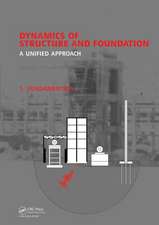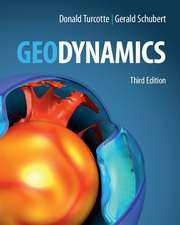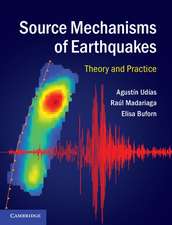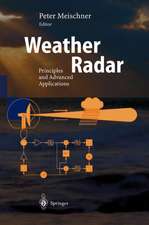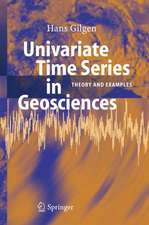Earthquake Analysis and Design of Industrial Structures and Infra-structures: GeoPlanet: Earth and Planetary Sciences
Autor Indrajit Chowdhury, Shambhu P. Dasguptaen Limba Engleză Hardback – 20 oct 2018
Despite significant development in earthquake analysis and design in the last 50 years or more, different structures related to industry, infra structure and human habitats get destroyed with monotonic regularity under strong motion earthquake. Even the recent earthquake in Mexico in September 2017 killed a number of people and destroyed national assets amounting to hundreds of millions of dollars.
Careful evaluation of the technology reveals that, despite significant development in earthquake engineering, most of the books that are available on the market for reference are primarily focused towards buildings and framed type structures. It is accepted that during an earthquake it is buildings that get destroyed most and has been the biggest killers of human life. Yet, there are a number of structures like retaining walls, water tanks, Bunkers, silos, tall chimneys, bridge piers etc that are equally susceptible to earthquake, and if damaged can cause serious trouble and great economic distress. Unfortunately, many of these systems are analyzed by techniques that are too simplified, unrealistic/obsolete or nothing is done about them, ignoring completely the seismic effects, as no guidelines exist for their analysis/design (like seismic analysis of counterfort retaining walls or dynamic pressures on bunker walls etc.).
This highly informative book addresses many of these items for which there exists a significant gap in technology and yet remain an important life line of considerable commercial significance.
The book is an outcome of authors' academic research and practice across the four continents (USA, Europe, Africa and Asia) in the last thirty two years, where many of these technologies have been put in practice, that got tested against real time earthquakes. All methods presented herein have been published previously in peer reviewed research journals and international conferences of repute before being put to practice.
Professionals working in international EPC and consulting engineering firms, graduates taking advanced courses in earthquake engineering, doctoral scholars pursuing research in earthquake engineering in the area of dynamic soil structure interaction (DSSI) and advanced under graduates wanting to self-learn and update themselves on earthquake analysis and design are greatly benefited from this book.
| Toate formatele și edițiile | Preț | Express |
|---|---|---|
| Paperback (1) | 1253.42 lei 6-8 săpt. | |
| Springer International Publishing – 14 feb 2019 | 1253.42 lei 6-8 săpt. | |
| Hardback (1) | 1260.20 lei 6-8 săpt. | |
| Springer International Publishing – 20 oct 2018 | 1260.20 lei 6-8 săpt. |
Din seria GeoPlanet: Earth and Planetary Sciences
-
 Preț: 253.30 lei
Preț: 253.30 lei - 15%
 Preț: 643.34 lei
Preț: 643.34 lei - 18%
 Preț: 898.89 lei
Preț: 898.89 lei - 15%
 Preț: 653.65 lei
Preț: 653.65 lei - 18%
 Preț: 730.97 lei
Preț: 730.97 lei - 15%
 Preț: 641.03 lei
Preț: 641.03 lei - 18%
 Preț: 945.79 lei
Preț: 945.79 lei -
 Preț: 388.13 lei
Preț: 388.13 lei - 15%
 Preț: 653.98 lei
Preț: 653.98 lei - 15%
 Preț: 633.53 lei
Preț: 633.53 lei - 15%
 Preț: 635.96 lei
Preț: 635.96 lei - 18%
 Preț: 956.03 lei
Preț: 956.03 lei -
 Preț: 418.07 lei
Preț: 418.07 lei - 15%
 Preț: 633.02 lei
Preț: 633.02 lei - 18%
 Preț: 1233.69 lei
Preț: 1233.69 lei - 15%
 Preț: 639.90 lei
Preț: 639.90 lei - 15%
 Preț: 641.71 lei
Preț: 641.71 lei - 15%
 Preț: 640.06 lei
Preț: 640.06 lei - 18%
 Preț: 967.40 lei
Preț: 967.40 lei - 15%
 Preț: 642.68 lei
Preț: 642.68 lei - 15%
 Preț: 639.90 lei
Preț: 639.90 lei - 15%
 Preț: 638.43 lei
Preț: 638.43 lei - 15%
 Preț: 643.34 lei
Preț: 643.34 lei - 20%
 Preț: 574.08 lei
Preț: 574.08 lei - 15%
 Preț: 640.06 lei
Preț: 640.06 lei - 15%
 Preț: 640.88 lei
Preț: 640.88 lei - 15%
 Preț: 649.87 lei
Preț: 649.87 lei - 15%
 Preț: 642.51 lei
Preț: 642.51 lei - 18%
 Preț: 948.47 lei
Preț: 948.47 lei - 15%
 Preț: 626.27 lei
Preț: 626.27 lei - 18%
 Preț: 970.87 lei
Preț: 970.87 lei
Preț: 1260.20 lei
Preț vechi: 1536.83 lei
-18% Nou
Puncte Express: 1890
Preț estimativ în valută:
241.17€ • 248.81$ • 204.11£
241.17€ • 248.81$ • 204.11£
Carte tipărită la comandă
Livrare economică 05-19 martie
Preluare comenzi: 021 569.72.76
Specificații
ISBN-13: 9783319908311
ISBN-10: 3319908316
Pagini: 810
Ilustrații: XXII, 1050 p. 424 illus., 142 illus. in color.
Dimensiuni: 155 x 235 mm
Greutate: 1.67 kg
Ediția:1st ed. 2019
Editura: Springer International Publishing
Colecția Springer
Seria GeoPlanet: Earth and Planetary Sciences
Locul publicării:Cham, Switzerland
ISBN-10: 3319908316
Pagini: 810
Ilustrații: XXII, 1050 p. 424 illus., 142 illus. in color.
Dimensiuni: 155 x 235 mm
Greutate: 1.67 kg
Ediția:1st ed. 2019
Editura: Springer International Publishing
Colecția Springer
Seria GeoPlanet: Earth and Planetary Sciences
Locul publicării:Cham, Switzerland
Cuprins
Global Seismicity and History of Earthquake Occurrence in India.- Basic Mechanics of Earthquake Resistant Design.- Soil Dynamics and Earthquake Engineering.- Earthquake Analysis of Earth Retaining Structures.- Dynamic Analysis of Earth Dams Under Earthquake.- Seismic Design of Shallow and Deep Foundations.- Dynamic Soil Structure Interaction in Earthquake Analysis.- Geo-technical Considerations for Seismic analysis.- Earthquake Resistant Design and Analysis of Buildings.- Earthquake Analysis of Tall Chimneys and Stack Like Structure.- Earthquake Analysis of Concrete Gravity Dam.- Earthquake Response of Bridge Piers and their Foundations.- Dynamic Response of Bunkers and Circular Silos under Earthquake Force.- Analysis of Water Tanks under Earthquake Force.
Recenzii
“This book is a thorough examination of all of the engineering considerations that are required. It is not for the casual reader but intended as a graduate-level textbook and reference for researchers and Practicing engineers. … this is a major work on an important subject. The book should be considered an essential addition to the library of any organization involved in geotechnical or structural engineering projects in earthquake zones.” (William R. Green, The Leading Edge, Vol. 38 (10), October, 2019)
Textul de pe ultima copertă
Despite significant development in earthquake analysis and design in the last 50 years or more, different structures related to industry, infra structure and human habitats get destroyed with monotonic regularity under strong motion earthquake. Even the recent earthquake in Mexico in September 2017 killed a number of people and destroyed national assets amounting to hundreds of millions of dollars.
Careful evaluation of the technology reveals that, despite significant development in earthquake engineering, most of the books that are available on the market for reference are primarily focused towards buildings and framed type structures. It is accepted that during an earthquake it is buildings that get destroyed most and has been the biggest killers of human life. Yet, there are a number of structures like retaining walls, water tanks, Bunkers, silos, tall chimneys, bridge piers etc that are equally susceptible to earthquake, and if damaged can cause serious trouble and great economic distress. Unfortunately, many of these systems are analyzed by techniques that are too simplified, unrealistic/obsolete or nothing is done about them, ignoring completely the seismic effects, as no guidelines exist for their analysis/design (like seismic analysis of counterfort retaining walls or dynamic pressures on bunker walls etc.).
This highly informative book addresses many of these items for which there exists a significant gap in technology and yet remain an important life line of considerable commercial significance.
The book is an outcome of authors' academic research and practice across the four continents (USA, Europe, Africa and Asia) in the last thirty two years, where many of these technologies have been put in practice, that got tested against real time earthquakes. All methods presented herein have been published previously in peer reviewed research journals and international conferences of repute before being put to practice.
Professionals working in international EPC and consulting engineering firms, graduates taking advanced courses in earthquake engineering, doctoral scholars pursuing research in earthquake engineering in the area of dynamic soil structure interaction (DSSI) and advanced under graduates wanting to self-learn and update themselves on earthquake analysis and design are greatly benefited from this book.
Caracteristici
Numerous step-by-step tutorials help the reader to learn quickly Contains a special chapter on next generation Flash Includes ten tips on how to protect flash sites from hackers



